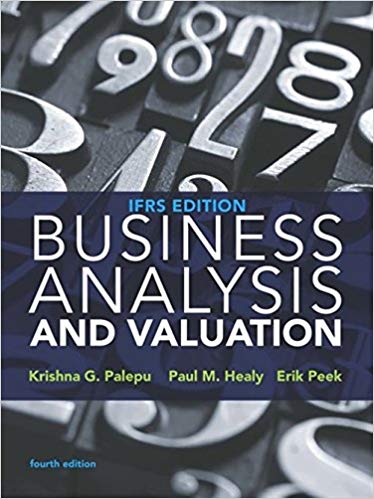This is completed downloadable of Solution Manual for Business Analysis and Valuation: IFRS edition

Product Details:
- ISBN-10 : 1473758424
- ISBN-13 : 978-1473758421
- Author:
Business Analysis and Valuation: IFRS edition uses a wide range of contemporary cases to illustrate the use of financial statement data in various valuation tasks. Centred around the IFRS Standards, this text demonstrates how to get the most information out of IFRS based financial statements. The focus is not only on building a solid understanding of the latest theoretical approaches but also placing students in a confident position to apply these.
Table of Contents
- Part I: Framework
- Chapter 1: A Framework for Business Analysis and Valuation Using Financial Statements
- The Role of Financial Reporting in Capital Markets
- From Business Activities to Financial Statements
- Influences of the Accounting System on Information Quality
- Alternative Forms of Communication with Investors
- From Financial Statements to Business Analysis
- Public versus Private Corporations
- Summary
- Core Concepts
- Questions, Exercises, and Problems
- Problem 1 The Neuer Markt
- Problem 2 Fair Value Accounting for Financial Instruments
- Notes
- Appendix: Defining Europe
- Case: The Role of Capital Market Intermediaries in the Dot-Com Crash of 2000
- Part II: Business Analysis and Valuation Tools
- Chapter 2: Strategy Analysis
- Industry Analysis
- Applying Industry Analysis: The European Airline Industry
- Competitive Strategy Analysis
- Corporate Strategy Analysis
- Summary
- Core Concepts
- Questions, Exercises, and Problems
- Notes
- Case: Akris: Competition in the High-End Fashion Industry
- Chapter 3: Accounting Analysis: The Basics
- Factors Influencing Accounting Quality
- Steps in Accounting Analysis
- Recasting Financial Statements
- Accounting Analysis Pitfalls
- Value of Accounting Data and Accounting Analysis
- Summary
- Core Concepts
- Questions, Exercises, and Problems
- Problem 1 Key Accounting Policies
- Problem 2 Fashion Retailers’ Key Accounting Policies
- Problem 3 Euro Disney and the First Five Steps of Accounting Analysis
- Notes
- Appendix A: First-Time Adoption of IFRS Standards
- Appendix B: Recasting Financial Statements into Standardized Templates
- Case: Toshiba: Accounting Fraud
- Chapter 4: Accounting Analysis: Accounting Adjustments
- Recognition of Assets
- Asset Distortions
- Recognition of Liabilities
- Liability Distortions
- Equity Distortions
- Summary
- Core Concepts
- Questions, Exercises, and Problems
- Problem 1 Impairment of Non-Current Assets
- Problem 2 Audi, BMW, and Skoda’s Research and Development
- Problem 3 H&M and Inditex’s Non-Current Assets
- Notes
- Case: Accounting for the iPhone Upgrade Program (A)
- Chapter 5: Financial Analysis
- Ratio Analysis
- Cash Flow Analysis
- Summary
- Core Concepts
- Questions, Exercises, and Problems
- Problem 1 ROE Decomposition
- Problem 2 Ratios of Three Fashion Retailers
- Problem 3 The Fiat Group in 2008
- Problem 4 Ahold versus Delhaize
- Notes
- Appendix: Hennes & Mauritz AB Financial Statements
- Case: Carrefour S.A.
- Chapter 6: Prospective Analysis: Forecasting
- The Overall Structure of the Forecast
- Performance Behavior: A Starting Point
- Forecasting Assumptions
- From Assumptions to Forecasts
- Sensitivity Analysis
- Summary
- Core Concepts
- Questions, Exercises, and Problems
- Problem 1 Predicting Tesco’s 2017/2018 Earnings
- Notes
- Appendix: The Behavior of Components of ROE
- Case: Forecasting Earnings and Earnings Growth in the European Oil and Gas Industry
- Chapter 7: Prospective Analysis: Valuation Theory and Concepts
- Defining Value for Shareholders
- The Discounted Cash Flow Model
- The Discounted Abnormal Profit Model
- The Discounted Abnormal Profit Growth Model
- Valuation Using Price Multiples
- Shortcut Forms of Profit-Based Valuation
- Comparing Valuation Methods
- Summary
- Core Concepts
- Summary of Notations Used in this Chapter
- Questions, Exercises, and Problems
- Problem 1 Estimating Hugo Boss’s Equity Value
- Problem 2 Estimating Adidas’s Equity Value
- Notes
- Appendix A: Asset Valuation Methodologies
- Appendix B: Reconciling the Discounted Dividends, Discounted Abnormal Profit, and Discounted Abnorma
- Case: Valuation Multiples in Fast Fashion
- Chapter 8: Prospective Analysis: Valuation Implementation
- Computing a Discount Rate
- Terminal Values
- Computing Estimated Values
- Some Practical Issues in Valuation
- Summary
- Core Concepts
- Questions, Exercises, and Problems
- Problem 1 Hugo Boss’s and Adidas’s Terminal Values
- Problem 2 Anheuser-Busch InBev S.A.
- Notes
- Case: Ferrari: The 2015 Initial Public Offering
- Part III: Business Analysis and Valuation Applications
- Chapter 9: Equity Security Analysis
- Investor Objectives and Investment Vehicles
- Equity Security Analysis and Market Efficiency
- Approaches to Fund Management and Securities Analysis
- The Process of a Comprehensive Security Analysis
- Performance of Security Analysts and Fund Managers
- Summary
- Core Concepts
- Questions
- Notes
- Case: Valuation at Novartis
- Chapter 10: Credit Analysis and Distress Prediction
- Why Do Firms Use Debt Financing?
- The Market for Credit
- Country Differences in Debt Financing
- The Credit Analysis Process in Private Debt Markets
- Financial Statement Analysis and Public Debt
- Prediction of Distress and Turnaround
- Credit Ratings, Default Probabilities, and Debt Valuation
- Summary
- Core Concepts
- Questions
- Notes
- Case: Getronics’ Debt Ratings
- Chapter 11: Mergers and Acquisitions
- Motivation for Merger or Acquisition
- Acquisition Pricing
- Acquisition Financing and Form of Payment
- Acquisition Outcome
- Reporting on Mergers and Acquisitions: Purchase Price Allocations
- Summary
- Core Concepts
- Questions
- Notes
- Case: Glencore/Xstrata: Playing Aida’s Triumphal March on Top of the Everest
- Part IV: Additional Cases
- 1 Enforcing Financial Reporting Standards: The Case of White Pharmaceuticals AG
- 2 KarstadtQuelle AG
- 3 Tesco: From Troubles to Turnaround
- 4 Valuing Europe’s Fastest Growing Company: HelloFresh in 2017
- 5 Spotify’s Direct-Listing IPO
- 6 The Air France-KLM Merger
- 7 Measuring Impairment at Dofasco
- 8 The Initial Public Offering of PartyGaming Plc
- 9 Two European Hotel Groups (A): Equity Analysis
- 10 Two European Hotel Groups (B): Debt Analysis
- 11 Fiat Group’s First-Time Adoption of IFRS Standards
- Index





